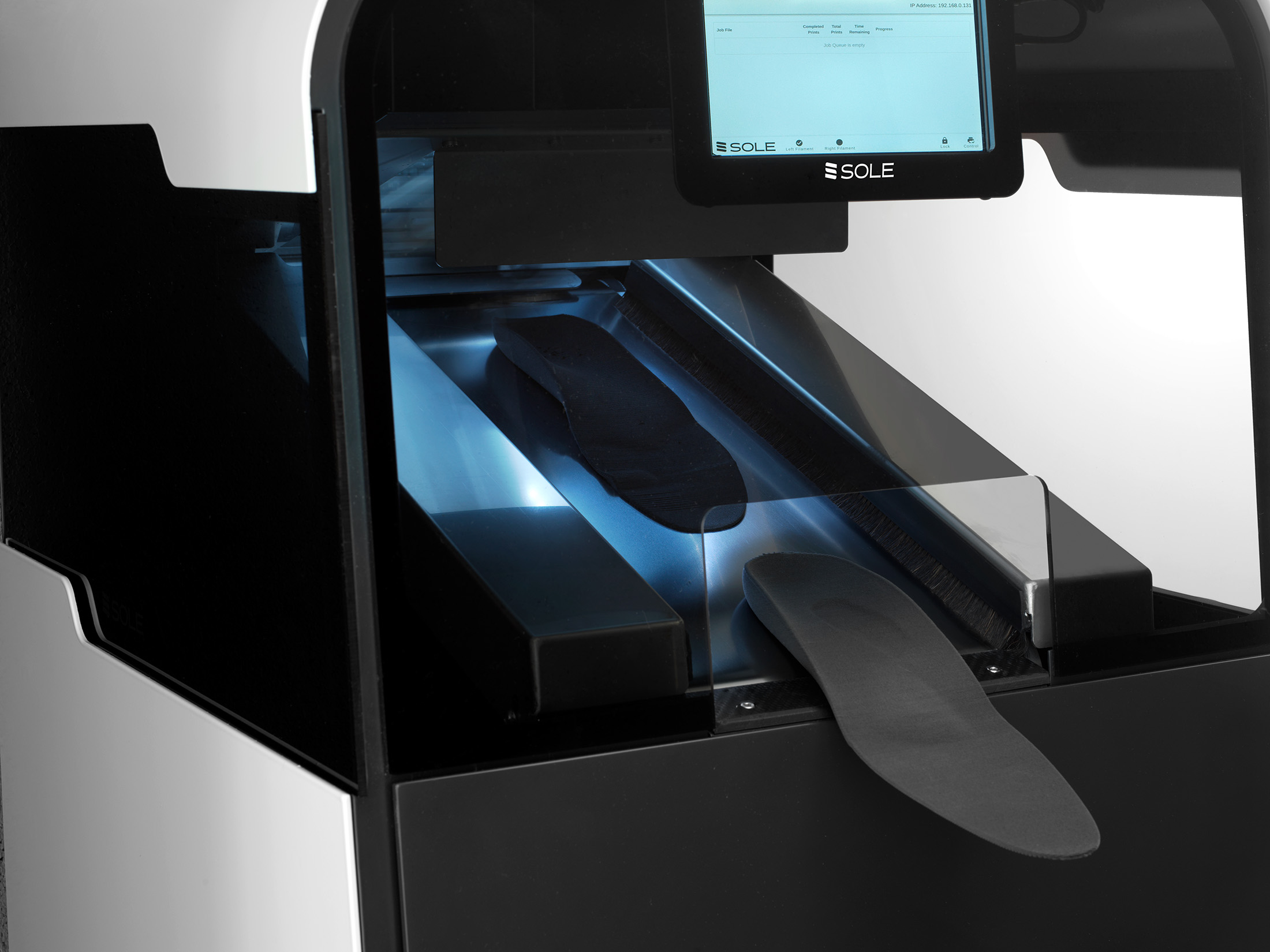Dutch company PodoPrinter developed SOLE, a 3D printer for podiatrist and orthopaedic shoemakers to create custom and medical insoles. The easy-to-use system based on FDM technology uses a dedicated foaming filament and specialised insole CAD software. According to the company no prior knowledge of 3D printing is required. In an interview with 3Druck.com, Sales and Marketing Manager Guus van Gestel details how additive manufacturing changes production in the shoe insole industry.
SOLE can be combined with almost any 3D scanning device. Starting out with a 2D or 3D scan of the foot, a customised insole can be designed using the company’s PodoCAD software including different categories and element libraries. The 3D printing process is fully automated, featuring a conveyor bet that enables 24/7 unmanned production.
The material used is a unique TPU foaming filament, offered in different colours. The shore hardness can be fine-tuned both within specific areas of an insole and across individual elements. This customization is made possible through the manipulation of active foaming, printing speed, layer height, and diverse infill structures. If customers prefer to have insoles with their own design a cover can be provided.
The SOLE 3D printer is suited for small and medium businesses or practices, offering high levels of accuracy and flexibility at a competitive price. Compared to traditional milling methods it also contributes to more a sustainable production through less material waste.
Interview with Guus van Gestel
In an interview with 3Druck.com, Sales and Marketing Manager Guus van Gestel details how additive manufacturing changes production in the shoe insole industry and comments on the current situation as well as future of 3D printing.
In your opinion, what significance does additive manufacturing have for the shoe insole industry?
The conventional way is doing the hard labor in dusty environments by yourself as a feet expert or outsourcing the craftsmanship to external companies, which costs more money and due to the milling method they carve away a lot of material resulting in up to 95% waste. With 3D printing you start with nothing and create something, so basically no waste.
As a result of the invention of printing under an angle on a conveyor belt with an automatic filament switching system you can create a flow of production and have your own little factory in your own place while the printer is smaller than a table refrigerator.
Due to the special TPU foaming filament the insoles are already a bit softer and because of the difference of the infill structure one can create different hardness in 1 print in 1 insole with 1 type of material.
Additive manufacturing has continuously developed in recent years. Which innovations or technological breakthroughs do you consider to be particularly important for your sector?
Our innovation started with belt-printing under an angle. So the prints will fall of from the belt by themselves and no support material is needed due to the angle. As long as the filament is replenished it can print indefinitely. Or it can at least print for 8 days continuously without loading new filament.
Another important innovation is the real time fault detection to create more uptime. With the AI camera’s different sensors and high spec components we create as much uptime as possible and that is important for our clients.
First Corona and the now high inflation pose major challenges for the entire industry. In your opinion, how do the multiple crises affect the additive manufacturing industry?
As a start-up growing into a scale-up we are disruptive and flexible enough to work around or embrace certain situations. Also our 3D printer is on the long run a cheaper alternative than the conventional method. So we don’t conciser these as major challenges but see it more as opportunities.
What impact do you think additive manufacturing will have on various industries and possibly society as a whole in the coming years?
The additive industry started off mainly in ‘rapid prototyping’ as there the time-to-market is very efficient; so from product innovations or product iteration the rapid prototyping industry is still growing.
Also now it becomes more and more ‘rapid manufacturing’ like what we offer with our 3D printer. 3D printing can be ‘manufacturing on demand’ and at the end of the day it means that less material is needed due to unnecessary stock.
Additionally the filaments will be more environmentally friendly like PHA filaments which are more organic and can be absorbed in nature.
Here you can find more information about the SOLE 3D printer from PodoPrinter.
Subscribe to our Newsletter
3DPresso is a weekly newsletter that links to the most exciting global stories from the 3D printing and additive manufacturing industry.






















